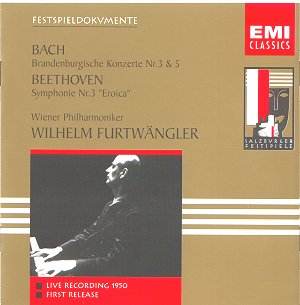BACH
BRANDENBURG CONCERTOS No 3 &
5
BEETHOVEN
SYMPHONY No 3,
'EROICA'
 Wiener Philharmoniker, Wilhelm
Furtwängler
Wiener Philharmoniker, Wilhelm
Furtwängler
 EMI Classics Festspieldokumente
CMS5 67422 2 (2 discs, 44'15 & 52'07), Mid Price (Recorded
Live 31 August
1950)
EMI Classics Festspieldokumente
CMS5 67422 2 (2 discs, 44'15 & 52'07), Mid Price (Recorded
Live 31 August
1950)
Crotchet
Amazon
UK
Amazon
USA

This 1950 performance (here released for the first time) of Beethoven's Eroica
from the Salzburg Festival takes to ten the number of different recordings
now available of Furtwängler conducting this work. He was a legendary
interpreter of it, with each recording (even the often less dramatic studio
recordings from 1947/9 and 1952) offering us a Promethean journey through
this most astonishing of symphonies. Despite the poor sound, one can quite
clearly hear the standard Furtwängler leitmotifs of angst, relentlessness,
power and sense of proportion that he alone brought to this work. It is,
by any counts, as grave and noble a performance as any of its predecessors.
All recordings of the Eroica stand in the shadows of Furtwängler's December
1944 performance, also with the Vienna Philharmonic. It is a recording of
rare breadth, particularly in the Funeral March, and one that gives us an
almost unparalleled use of dynamics. Allowing for the adjustments made to
pitch, this 1950 recording is very close to it in terms of tempo and very
close to the 1944 account in terms of mood.
The second movement offers some very telling comparisons. There is a similar
broadening to the movement as it develops, with the double fugue gloriously
transfigured and the tumultuous outburst that follows it breaching the walls
of catastrophe. Indeed, Furtwängler is almost alone in how he breaks
this movement down into its two separate parts - the triumphant opening trio
with its bursts of light, and the darker second episode with its grief-stricken
harmonies. Both in 1944 and 1950 you sense the tragedy of this symphony -
and that the Funeral March is at the centre of it.
The Scherzo is more delicate, even deft, in the later recording with a delicacy
to the textures that makes it almost seem lightweight by comparison with
the wartime Eroica. The concluding Allegro Molto, however, is just magnificent.
From the fiery opening (always common to Furtwängler's conception of
this movement), to the fugue and the glorious double variations both playing
and conducting are a miracle of creation. The horn chorale at 8'50, for example,
emerges like a bursting dam with a power to match but how wonderfully
Furtwängler controls it so the pianissimo that falls in at 9'38
does so almost imperceptibly. The coda, as profound as it was meant to be,
blazes uncontrollably. In the end, this is Beethoven interpretation of the
very highest order.
The booklet notes incorrectly date this Eroica (twice) as having been performed
on 31 August 1951. On that very date Furtwängler was, in fact, conducting
Beethoven's Ninth.
The coupling for this Eroica is a performance of Bach's Brandenburg Concertos,
Nos 3 and 5. EMI's booklet notes are, however, misleading by claiming this
is a first release. Both the Bach appeared on a Japanese Refrain CD, and
before that twice on LP (once on Nippon and once on Discocorp). The performances,
however, are extraordinary both for the quality of the playing, which offers
ensemble playing of rare precision, and for Furtwängler's wonderfully
sensitive piano playing (in No 5).
These are not, however, recordings for purists. Not only does Furtwängler
use a full string section he also ignores Bach's stated tempi. The opening
movement of the Concerto No 3, for example, is marked allegro, but
Furtwängler actually takes it maestoso. The effect is extraordinary,
the dynamics more heavily stressed than perhaps in any other recording of
the work. By way of contrast, the opening of the third movement (taken in
tempo) has string arpeggios of the utmost lightness.
For the Concerto No 5, Furtwängler uses a standard piano (even though
harpsichords were used at the time). The opening, therefore, has the effect
more of Schubert than of Bach. You will hear the bass line in the continuo
played in octaves and there are some extremely Brahmsian left-hand chords
that add further weight to this astonishingly heavy performance. The interplay
between Furtwängler, and his two principals (Boskovsky on violin and
Niedermayer on flute) is, however, an object lesson in great ensemble playing.
The performance is more expansive than any other, but somehow captures the
imagination. Its idiosyncrasies will not bear repeated listening, but as
an example of supreme music making it is hard to think of anything quite
as thought provoking and controversial as this.
The Beethoven performance is, I think, essential listening - and not just
for Furtwängler devotees. The Bach will either compel you or repulse
you ; there really is no middle ground with these performances. In summary,
a quite remarkable pair of discs.
Marc Bridle
Performances -
Beethoven

Bach

Sound

